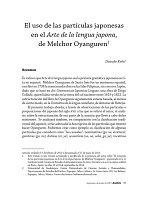The use of japanese particles in the Arte de la Lengua Japona, of Melchor Oyanguren
DOI:
https://doi.org/10.32870/mycp.v4i12.493Keywords:
Japanese grammar, Seventeenth Century Japanese, particles, postpositions, OyangurenAbstract
It is significant that Arte de la Lengua Japona is the first Japanese grammar book written in Spanish. Melchor Oyanguren de Santa Inés was a Spanish missionary. In 1738, he wrote the mentioned work in the Philippines without knowing Japan, since it was based on Ars Grammaticae Iaponicae Linguae, a work by Diego Collado, who had lived in the land of the rising sun between 1619 and 1622. The structure of the book by Oyanguren would be based, in some sense, on Grammar of the Castilian Language, by Antonio de Nebrija. This present work undertake through observations of particles or postpositions of seventeenth century’s Japanese to which the author has referred, the analysis about the structuring of the part of the sentence constructed by the missionary. It will also be review, in comparison with the traditional classification of Japanese, whether it was an adequate description of the particles that Oyanguren tried to make. Also will be cited as an example, the classification of some particles that he considered as “casuals”: nominatives (ga, ua, and so on); genitives (ga, no); datives (ni, ye); accusatives (uo, ua, uoba, ga, ye); vocatives (icani); ablatives (yori, cara, ni, de), most probably based in the concept and terminology of Latin, which is different from traditional Japanese grammar.Downloads
References
Alvar, Manuel (1997), “La gramática del japonés en Melchor Oyanguren de Santa Inés”, en Manuel Alvar (ed.), Nebrija y estudios sobre la Edad de Oro, Madrid, Consejo Superior de Investigaciones Científicas. pp. 39-51.
Bae, Eun Mi (2005), El sistema pronominal en la gramática del japonés del franciscano Melchor Oyanguren de Santa Inés (siglo XVIII): ¿Tradición y/u originalidad?, tesis de licenciatura, Oslo, Universidad de Oslo.
Frellesvig, Bjarke (2010), A History of the Japanese Language, Cambridge, Cambridge University Press.
Gili Gaya, Samuel (1961), Curso superior de sintaxis española, Barcelona, Biblograf.
González Carrillo, Antonio Manuel (2009), “El magisterio de Antonio de Nebrija en la historiografía gramatical española del siglo XVIII: el caso de Melchor Oyanguren de Santa Ynés”, en José María García Martín y Victoriano Gaviño Rodríguez (coord.), Ideas y realidades lingüísticas en los siglos XVIII y XIX, Cádiz, Servicios de Publicaciones de la Universidad de Cádiz.
Goto, Keiko (1989), “Production and Judgement of the Case Particles ‘ga’ and ‘wo’ in Simple Transitive Sentences among Preschool Children”, Choonoo gengogaku kenkyuu (Estudios lingüísticos auditivos), 6, pp. 12-9 .
Hashimoto, Shinkichi (1969), Joshi jodooshi no kenkyuu (Estudios sobre las partículas y los verbos auxiliares), Tokio, Iwanami Shoten.
Iwasaki, Shoichi (2013), Japanese, ed. revisada, Philadelphia, John Benjamins Publishing Company.
Kato, A.; Saji, K. y Y. Morita (2000), Nihongo Gaisetsu (Introducción a la lengua japonesa, Tokio, Ohfuu.
Lope Blanch, Juan M. (1971, 1976), El habla de la ciudad de México: Materiales para su estudio, México, UNAM.
Lope Blanch, Juan M. (1978), Léxico del habla culta de México: Materiales para su estudio, México, UNAM.
Martínez Amador, Emilio M. (1985), Diccionario gramatical y de dudas del idioma, Barcelona, Ramón Sopena.
Matsumura, Akira (1957), Edogo Tokyogo no Kenkyuu (Estudios del habla de Edo y de Tokio), Tokio, Tokyodo.
Matsumura, Akira (1988), Daijirin (Gran diccionario), Tokio, Sanseido. Nebrija, Antonio de (1980 [1492]), Gramática de la lengua castellana, estudio y ed. de Antonio Quilis, Madrid, Editora Nacional.
Nebrija, Antonio de (1980 [1492]), Gramática de la lengua castellana, estudio y ed. de Antonio Quilis, Madrid, Editora Nacional.
Okada, Yoshimi (2012), “Joshi /ga/ to /wo/ no kenkyuu: /mizuga nomitai/ /mizuwo nomitai/ kara” (“Estudios de las partículas ga y wo: a partir de mizuga nomitai y mizuwo nomitai”), Mie Daigaku Nihongogakubungaku, 23. pp. 78-92.
Okimori, Takuya (2012), Hajimete yomu Nihongo no Rekishi (Historia de la lengua japonesa a primera vista), Tokio, Beret Co Jp.
Real Academia Española (2001), Diccionario de la lengua española, 22a ed.,Madrid, Espasa Calpe.
Saeki, Umetomo (1977), Kokugo gaisetsu. Kaiteiban (Introducción al idioma japonés), ed. corregida, Tokio, Shueishuppan.
Seco, Rafael (1973), Manual de gramática española, Madrid, Aguilar. Shibatani, Masayoshi (2013), “What can Japanese Dialects tell us about the Function and Development of the Nominalization Particle ‘no’”, Japanese/ Korean Linguistics, 20, pp. 421-444.
Shinmura, Izuru (1978), Koojien (Wide Garden of Words), Tokio, Iwanamis- hoten.
Shuzui, K., Imaizumi, T. y A. Matsumura (ed.) (1970), Ohbunsha Kogo Jiten. Kaitei shinpan (Dicccionario de los arcaísmos Obunsha), nueva ed. corregida, Tokio, Obunsha.
Sullivan, Thelma D. (1976), Compendio de la gramática náhuatl, México, UNAM.
Todo sobre Japón (2003), Tokio, Kodansha Internatinal.
Tokieda, Motoki (1954), Nihon bunpoo. Bungohen (Gramática japonesa. Versión del lenguaje escrito), Tokio, Iwanami Zensho.
Yamada, Takao (1936), Nihon bunpoogaku gairon (Introducción a la gramática japonesa), Kobe, Hoobunkan.
Yáñez R.; Rosa, H. y Daisuke Kishi (2014), Arte de la lengua japona de Melchor Oyanguren de Santa Inés, colección Lenguas Indígenas, Guadalajara, Universidad de Guadalajara y Biblioteca Pública del Estado de Jalisco.
Weblio Kogojiten (s./f.), Disponible en: http://kobun.weblio.jp/content/をば. Consultado: 5 de agosto de 2014.
Zwartjes, Otto (2009, Melchor Oyanguren de Santa Inés: Arte de la lengua japona (1738), Madrid, Iberoamericana.

Downloads
Published
How to Cite
Issue
Section
License
Open Access Policy
This journal provides open access to all its contents, in adherence to the principle that making research freely available supports a greater global exchange of knowledge.
MyCP is licensed under a Creative Commons Attribution-NonCommercial license, also known as CC BY-NC.
Contents are published in both PDF and XML formats.
Authors who publish in México y la Cuenca del Pacífico must accept the following conditions:
Pursuant to Mexican copyright laws, México y la Cuenca del Pacífico acknowledges and respects the authors’ moral right and ownership of property rights, which will be assigned to the University of Guadalajara to publish the articles in an open-access mode.
México y la Cuenca del Pacífico does not charge the authors any fees for receiving and processing their articles.
Authors are permitted to enter into other independent and additional contractual agreements for the non-exclusive distribution of the article version published in México y la Cuenca del Pacífico (for example, publishing it in an institutional repository or in other printed or electronic media) as long as they clearly state that the piece was originally published in México y la Cuenca del Pacífico.
Pursuant to the above, once the article is approved for publication, authors must send the Assignment of Rights Agreement form duly filled and signed. This form must be sent to mexicoylacuenca@gmail.com as a PDF file.
Readers/users of México y la Cuenca del Pacífico can freely access the journal new issues as soon as they are uploaded. Readers/users are allowed to cite, share (both electronically and physically), print and distribute the material, provided they expressly state that the work was originally published in México y la Cuenca del Pacífico. Contents are to be properly cited and never for commercial purposes.




